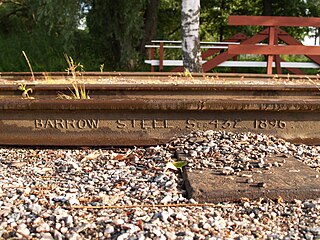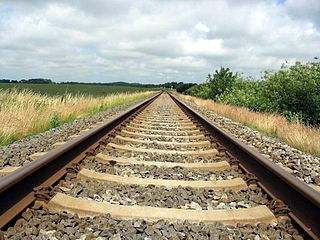
A broad-gauge railway is a railway with a track gauge broader than the 1,435 mm used by standard-gauge railways.

The Great Western Railway (GWR) was a British railway company that linked London with the southwest and west of England, the West Midlands and most of Wales. It was founded in 1833, received its enabling Act of Parliament on 31 August 1835 and ran its first trains in 1838. It was engineered by Isambard Kingdom Brunel, who chose a broad gauge of 7 ft —later slightly widened to 7 ft 1⁄4 in —but, from 1854, a series of amalgamations saw it also operate 4 ft 8+1⁄2 in standard-gauge trains; the last broad-gauge services were operated in 1892.

In rail transport, track gauge is the distance between the two rails of a railway track. All vehicles on a rail network must have wheelsets that are compatible with the track gauge. Since many different track gauges exist worldwide, gauge differences often present a barrier to wider operation on railway networks.

A railway track or railroad track, also known as permanent way or simply track, is the structure on a railway or railroad consisting of the rails, fasteners, railroad ties and ballast, plus the underlying subgrade. It enables trains to move by providing a dependable surface for their wheels to roll upon. Tracks where electric trains or electric trams run are equipped with an electrification system such as an overhead electrical power line or an additional electrified rail. Early tracks were constructed with wooden or cast iron rails, and wooden or stone sleepers; since the 1870s, rails have almost universally been made from steel.

The railway track or permanent way is the elements of railway lines: generally the pairs of rails typically laid on the sleepers or ties embedded in ballast, intended to carry the ordinary trains of a railway. It is described as permanent way because in the earlier days of railway construction, contractors often laid a temporary track to transport spoil and materials about the site; when this work was substantially completed, the temporary track was taken up and the permanent way installed.

A railroad tie, crosstie, railway tie or railway sleeper is a rectangular support for the rails in railroad tracks. Generally laid perpendicular to the rails, ties transfer loads to the track ballast and subgrade, hold the rails upright and keep them spaced to the correct gauge.
The Bristol and Gloucester Railway was a railway company opened in 1844 to run services between Bristol and Gloucester. It was built on the 7 ftBrunel gauge, but it was acquired in 1845 by the 4 ft 8+1⁄2 instandard gauge Midland Railway, which also acquired the Birmingham and Gloucester Railway at the same time.
High-speed railway track construction is the process by which Lignes à Grandes Vitesses, the land on which TGV trains are to run, is prepared for their use, involving carving the track bed and laying the track. This construction technique is used both for the French TGV network and other TGV-based networks outside of France.

The Loughor railway viaduct carries the West Wales Line across the River Loughor. It is adjacent, and runs parallel to, the Loughor road bridge. The 1880 viaduct was granted Grade II listed building status. Before it was demolished in early 2013, the viaduct was the last remaining timber viaduct designed by Isambard Kingdom Brunel.
The West Cornwall Railway was a railway company in Cornwall, Great Britain, formed in 1846 to construct a railway between Penzance and Truro. It purchased the existing Hayle Railway, and improved its main line, and built new sections between Penzance and Hayle, and between Redruth and Truro, and opened throughout in 1852.
The South Wales Railway was a main line railway which opened in stages from 1850, connecting the Great Western Railway from Gloucester to South Wales. It was constructed on the broad gauge. An original aspiration was to reach Fishguard to engender an Irish ferry transit and transatlantic trade, but the latter did not materialise for many years, and never became an important sector of the business. Neyland was the western terminus of the line until 1906.

The rail profile is the cross sectional shape of a railway rail, perpendicular to its length.

The network of railways in Plymouth, Devon, England, was developed by companies affiliated to two competing railways, the Great Western Railway and the London and South Western Railway. At their height two main lines and three branch lines served 28 stations in the Plymouth area, but today just six stations remain in use.

A concrete sleeper or concrete tie is a type of railway sleeper or railroad tie made out of steel reinforced concrete.

Barlow rail was a rolled rail section used on early railways. It has wide flaring feet and was designed to be laid direct on the ballast, without requiring sleepers. It was widely adopted on lightly trafficked railways, but was ultimately unsuccessful because of maintenance difficulties.

The Culm Valley Light Railway was a standard gauge branch railway that operated in the English county of Devon. It ran for just under 7+1⁄2 miles (12.1 km) from Tiverton Junction station on the Bristol to Exeter line, through the Culm valley to Hemyock.

Iberian gauge is a track gauge of 1,668 mm, most extensively used by the railways of Spain and Portugal. This is the second-widest gauge in regular use anywhere in the world. The Indian gauge, 5 ft 6 in, is 8 mm wider.

A rail fastening system is a means of fixing rails to railroad ties or sleepers. The terms rail anchors, tie plates, chairs and track fasteners are used to refer to parts or all of a rail fastening system. The components of a rail fastening system may also be known collectively as other track material, or OTM for short. Various types of fastening have been used over the years.
Ladder track is a type of railway track in which the track is laid on longitudinal supports with transverse connectors holding the two rails at the correct gauge distance. Modern ladder track can be considered a development of baulk road, which supported rails on longitudinal wooden sleepers. Synonyms include longitudinal beam track.

A bogie bolster wagon is a British railway term for a wagon designed to carry long thin cargoes such as timber or rails and other steel sections. The sides and ends are minimal and there is no roof. The load is carried longitudinally and borne by three or more bolsters fixed transversely. The load is constrained sideways by movable metal stanchions fitted into the ends of the bolsters, and secured with chains and shackles.
















